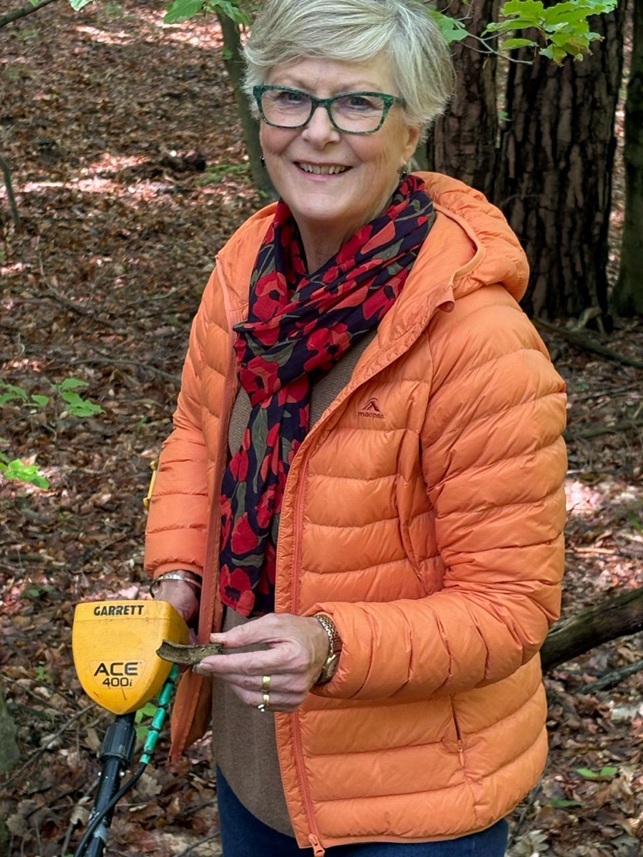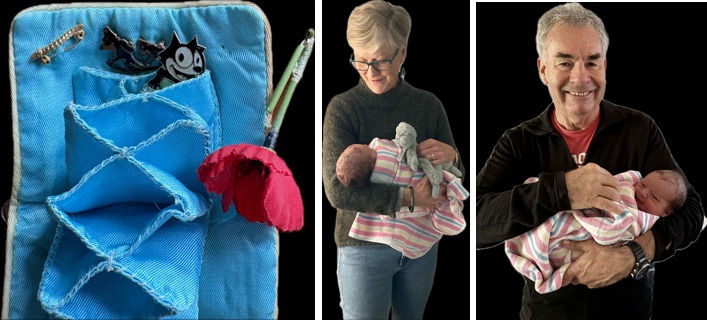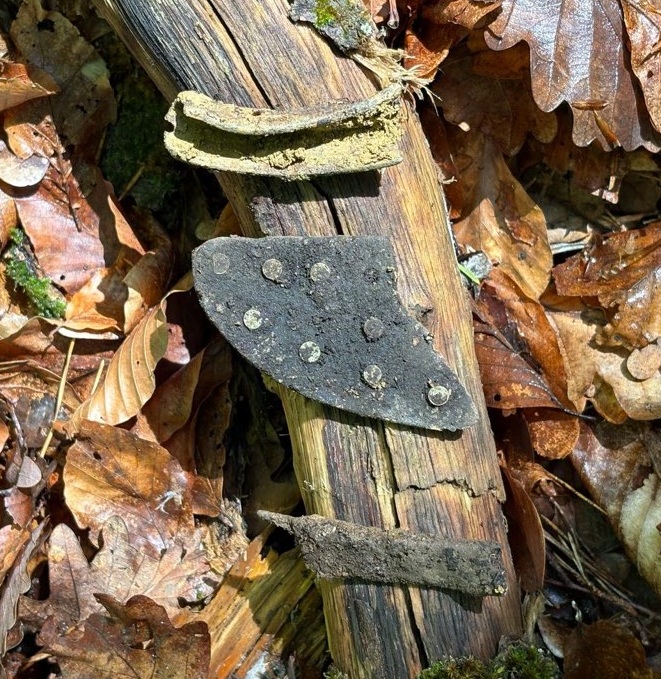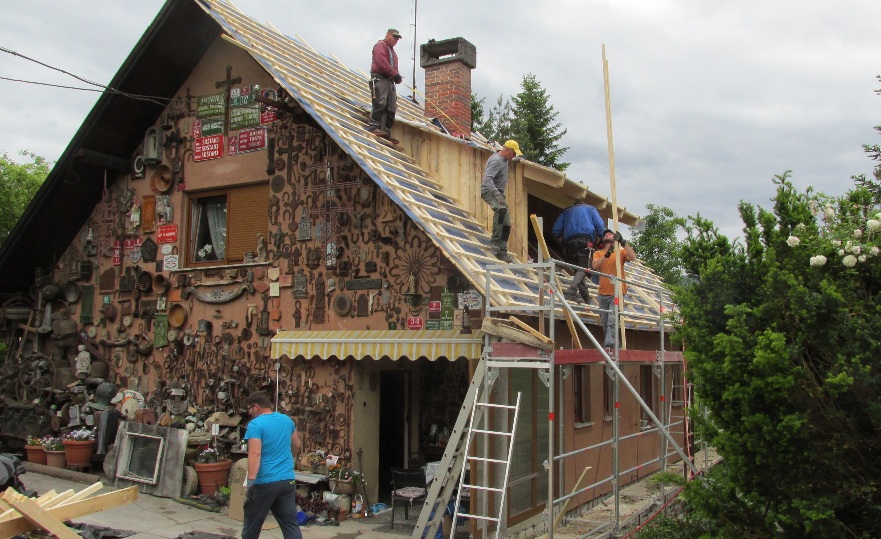
Fiona with metal detector, and a piece of her dad's WW2 Mustang!
An Archaeological Photo Essay from
3SQN Association Member Fiona MURRAY.
[Daughter of Mustang Pilot Al CLARK.]
A
day in the woods in pursuit of PLANES.
A.K.A. "Felix’s Big Day Out..."

Fiona with metal detector, and a piece of her dad's
WW2 Mustang!
![]()

Fano, Italy. Mustang MkIII KH631 "CV-V" prepares to
depart on a bombing mission.
![]()
Sunday 27th April 2025...
The most remarkable day in my life so far; 80 years after Dad was shot down in occupied Yugoslavia in April 1945.
We were met in the hotel foyer by our new friend Samo at 8am sharp. Samo is an interesting fellow. He is a Slovenian pilot who speaks great English and lives in remote Canada where he works and flies in the Arctic region. Samo comes back to his home village in Slovenia to see his mum and sister for four months each year.

I was wearing my poppy scarf for ID and our beloved "Felix" and Dad’s caterpillar pin.

I showed Samo the badges and explained the significance of them. He seemed to understand the reason why Felix is so special to us all.
It was glorious weather as we went out of the hotel to meet Miha. Miha was standing, waiting with the car, greeting me with tears in his eyes and a big bear hug. Samo hopped in front, navigating and translating for us. Interesting guy, with insights on world politics, capitalism and local history. Also an avid aviation historian.
After a short drive with lots of explanations and plans, we stopped at a huge restaurant with a magnificent view (of the kind of territory Dad had to traverse) in front of us. It was very crowded with busloads of people and no spare seats. So Pete bought take-away coffees and Samo bought a large box of specialty doughnuts for us all. We much preferred eating and drinking at a picnic table outside in the quiet, taking in the expansive view.

I showed Miha both 'Felix' and the caterpillar badges and Samo explained Felix’s history of 100 years good luck for the family, including being pinned inside Dad’s lapel when he was shot down. For some reason, for me, having Felix there again, after so many years, made me even more emotional. I took my Felix cap to wear as well, so they could see the modern Felix.So, into the woods.
We drove to the crash site in a rural area and met another aviation historian Igor Tratnik. Lovely older gentleman with huge knowledge, respect and interest. He had read dad’s memoir extensively. He walked down into the woods beside me and told me he had a relative in Australia, a good mathematician... Turns out his cousins’s daughter is Lily Serna from SBS TV quiz show Letters and Numbers. We love Lily and she is a brilliant mathematician.

Before Miha swung into action, I gave him his own 'good luck' Felix badge; a modern day version, not the 100-year-old special one that we treasure and need back home in Oz to help bring luck to our next generations.
Two younger Slovenian men (no English) arrived who are locals and who had helped Miha find the crater. They had 6-year-old Martin with them, who was excited and spoke non-stop in Slovenian to us all. He seemed to understand English though, perhaps because he watches cartoons on TV. The crater was revealed and we saw it was full of country rubbish; things of no use anymore. Miha was happy because that meant people left the site alone. Much busy activity as Miha got out all his gear, including two kinds of metal detectors, and began searching.
They found an old coat button and continued. I was worried there may be a body under there...
They got me to try in another close area, but no luck. Pete then had a turn and was very successful. In total, 8 pieces of dad’s plane found, including a crushed bullet! Amazing.

I started cleaning the mud off with a stick and lots of Slovenian encouragement from 6-year-old Martin.
I then had to explain to Samo that Australian Customs would not let us bring them into the country. There was much disbelief and grumbling and we discussed posting them.
Samo had brought a special memorial candle and lit it for me to place on the crash site (with the other junk). Such a thoughtful and beautiful thing to do. Martin was keen to help so we went into the crater with him chatting in Slovenian the whole time. I placed the candle and the poppy that Debbie had sent with me.
As a side note, when the locals left (Martin’s dad was one of them) he hopped in the car with an old paint tin. He called me over to show me his treasure and patted it on the lid. So cute.
All the while Igor and Samo were discussing the history and events and were taking photos. We were there for about an hour.
Back in the car and a little way up the road Miha jumps out and talks to an older woman and a younger man on a farm. These people had helped Miha too. The young man went inside and out came the homemade schnapps for Samo, Pete and I (not for the drivers).
I had a sip and then we had to "skĺl". (It was quietly made clear that it would be offensive if we did not do so.) Pete saved me by taking half of mine. Strong stuff. Slovenians love a drink or two. Hosts so welcoming and hospitable.
Had another stop at another couples’ farmhouse who had also helped Samo. At this stage the coffee had kicked in and we needed to use their toilet. No problem. We were welcomed into an immaculate toilet room. Very typical. Dad even mentioned that in his memoir.
Next stop was a much more affluent-looking farmhouse with two generations living next to each other. Miha bounded in once more and they looked decidedly unimpressed. They didn’t remember him or the crashed plane story. After a short chat with the grandmother in her 60s we were sent on our way.
Next stop was lunch in a lovely local, traditional Slovenian restaurant across the road from the fields where they believe Dad parachuted to. Quite flat and no trees or hills in sight. Igor kept wondering where the hill that Dad described in his memoir was. That mystery is still to be solved.
We sat down to a 3 course meal at a large table. Miha, Samo, Igor, Pete and myself sitting opposite Miha. The restaurant was buzzing with locals enjoying a drink and a large, long Sunday lunch. First course delicious mushroom soup, then chicken schnitzel with salad, rice and mashed spuds. Huge. Before dessert arrived (Apple Strudel; which Samo says a woman must be able to make before they can marry) I saw Miha sneak out and get cleaning gear. He came back with all the pieces of treasure clean as a whistle. We dried them on a napkin and said that they may pass through bio security checks in Sydney. We will see.
Then, much to my surprise, becoming very touched and moved, Miha presented me with a pristine box with an inscription on the lid saying: “Pilot Alan Clark, 3 Squadron RAAF. Mustang III P51 KH631 03/04/1945." Inside was a medium-sized lump of melted metal, mounted on Perspex and inscribed.
“Meeting’s Memory with the relatives of Pilot Alan Clark. Slovenia 27.04.2025.”
There was much discussion and scorn about Border Security, with me thinking we’ll be on 'Border Patrol' when we reach Sydney airport! We will definitely be declaring these precious ‘goods’ when we arrive. Miha also gave me a signed copy by the author of the Black Crow story (Aussie Ralph Churches memoir) in Slovenian. He had inscribed a lovely message. Again so thoughtful.
We finished dessert and piled out in front of the restaurant with the box and extra plane pieces for yet another photoshoot. Glorious day with the field in the background.

We farewelled Igor at this point, who had taken down copious notes and given us a large map of Slovenia. Very helpful.
Then our next adventure was to drive to the site of Ralph Churches Black Crow route where he helped many POWs escape from the Nazis with the help of the Partisans. It is a popular hiking trail with yellow circles with a black crow in the middle as signposts.
We parked by a narrow, raging river near the hydro electricity station. Unfortunately, Miha’s car broke down, making weird noises. As Miha says, “No Emergency,” as he proceeded to organise a tow truck with an exchange car. During our 2-hour wait it gave me time to observe the hills and forests around us with the fast moving river next to us. The hydro electricity stations are all along the river. It also was a real-time observation of the terrain and trials that Dad and [US pilot and evader] Clark CORNELL would have encountered. Very beautiful and peaceful too.
As the men had all relieved themselves I was in a bit of a hurry by then (late Sunday afternoon) to find an open venue with toilets. In a small village we stopped outside a pub and Samo escorted me into the premises. He bought some bottles of Coke for us so I didn’t feel bad for using the facilities. Ever thoughtful, our Samo.
We then discovered an ice cream shop and we all enjoyed a treat.
We made our way to Samo’s village Šoštanj and his mother’s home with the daylight starting to fade. Miha started to speak to the neighbours next to the memorial for the B17 that had crashed next to Samo’s farm, as the three of us looked at the memorial and lit a candle in memory .
The previous day there had been a large memorial service with many dignitaries attending and there were floral tributes still there. Very moving.
Samo’s mum was ill and his sister was looking after her, so we farewelled Samo there. Not without him giving us Slovenian wine, chocolate, left-over doughnuts and ginger chews! Amazingly generous, thoughtful and kind.

So off we drove, Miha at the wheel with Pete as co-pilot, me in the back and into the night to drive us back to Ljubljana. Much laughter and fun as Pete used Google Translate (no voice just writing) trying to communicate and pronounce Slovenian words.
By the way, Miha is a great driver.
We arrived at our hotel at 10pm and had to say a fond but sad farewell to Miha. What an incredible man. He still had an hour and a half to drive home up near the Austrian border (hence his mountain climbing). Miha is off to Albania (climbing) soon and he is still (always!) looking for WWII plane crash sites.
Such an incredible memorable 14-hour day, for which we will be forever grateful.
As a Postscript; we declared our precious plane pieces at Customs in Sydney. They were all in Pete’s suitcase, safe and sound. The Customs officer asked us what we were declaring. She was nonplussed at our story, as though it was an everyday occurrence that people would be bringing into Australia pieces of a WWII plane. So without even looking at anything and being reassured that we had cleaned the pieces (thanks Miha!) and the fact we had cleaned our shoes, she waved us through! No Emergency, Miha.
- A very happy ending to our trip.Fiona Murray
May 2025.
Archaeologist Miha sent Fiona his own impressions of the day...
(Translated from Slovenian:)

A DAY IN YOUR LIFE THAT YOU WILL NEVER FORGET
The beginnings of my research and search for crashed planes were like building an airplane out of Lego bricks, of different colors. The variety of colors of the bricks did not bother me.
Over time, I realized with the help of my research friends, especially Igor Tratnik, that the individual parts of the found airplane must be assembled from bricks of the same color. For example, if the Mustang P-51 airplane is blue, all the bricks must be blue. This is the only way you can determine the type of airplane and other important information about the airplane that you find in nature and that is being researched.
Why am I describing this? At the very beginning, when I, with the help of local people living in Sestrže, found the place where Alan Clark's plane crashed, I naively determined that this plane was a P-38 – Lightning No. 44-24189, which crashed in the nearby area. I eventually found out that this was the plane of his fighter pilot colleague Clark CORNELL, who force-landed on March 14, 1945 near the town of Draženci.
My second search of the crash site turned the plane's information on its head. I found parts with numbers indicating that the parts belonged to a P-51, or Mustang.Now aviation researcher Igor Tratnik has come forward. From his research literature, he found out that Alan Clark's plane crashed here on April 3, 1945. This is near the town of Savinsko. He landed with a parachute in the vicinity of Strug, was rescued by locals and taken further by partisans.
I have been corresponding with James Oglethorpe, who works at the 3 Squadron Association, for some time now. He helps me with accurate data on downed planes and individual aircraft parts in Slovenia. He also helped me with Clark's plane, getting in touch with Clark's relatives. Especially his daughter Fiona Murray, with whom I am in contact.
I also sent some parts of the father's plane to the family in Australia, which I found at the site where the plane crashed. They were happy and touched.Her son came to Slovenia in 2017 and traveled according to grandfather's written diary. From Ptuj, he traveled through Pohorje, past Trbovlje and on to Trieste, where the Allies were. At that time, I did not know that this plane was piloted by his grandfather Clark.
Daughter Fiona and her husband Peter were also tempted to come to the place where their father's plane crashed. In the Spring of 2025, they decided to travel around Europe and spent the last week visiting Slovenia. When I received the letter with this intention, I was very happy and euphoric, because this does not happen every year. In fact, this has been the first time for me. I was wondering how to carry out the meeting together.
The day Fiona and Peter would arrive was approaching. It happened on 27.04.2025. They spent the night in a hotel in Ljubljana. We had arranged to meet them at 8 o`clock in front of the hotel. But it was a disaster. All the days until Saturday had been rainy, very wet. I was worried about what a visit to the site of the crashed plane would be like if everything was wet and dreary.
I got up early on Saturday morning. When I looked out the window, I saw a blue sky, clear enough to make your heart skip a beat. Because I live in a place not close to Ljubljana, I picked up Samo Čebul from Šoštanj, a pilot who works in Canada.
A handshake and a satisfied look to see the expected guests in front of me. The four of us will be together all day long.It is a two-hour moderate drive to the place where the plane crashed. On a sunny day, it is a pleasant drive. Through the windows, the guests could see how green our little Slovenia is.
Igor Tratnik joined us in Savinsko. The mood was pleasant, sunny, a dry forest and we headed towards the place where Clark's plane crashed. It was not far. The forest road leads along a convex, rounded ridge. As the ridge starts to descend, there is a larger hole, indicating where the locals dug up larger parts of the plane. Now that Fiona and Peter were with us, I also felt that this place is now consecrated. It has a part of Clark's history, which he experienced eighty years ago and today it is visited by his daughter and her husband. A truly profound feeling. Let it last.
Fiona and Peter themselves used a detector to search for metal parts of the plane that have remained in the ground to this day. I thought they will be even more precious than the ones I sent to Australia. We lit a candle to commemorate this event, many years ago.
Time passed. We also went to the village of Strug, where pilot Clark landed with a parachute. During my research visits to the village, I did not find any elderly people who would remember the pilot's landing.
After lunch, we headed towards Ljubljana. In Šoštanj, we visited a monument dedicated to two planes that crashed nearby.
We arrived in Ljubljana late in the evening, already deep in the darkness. I said a warm goodbye to Fiona and Peter and was aware that it had been an unforgettable day.